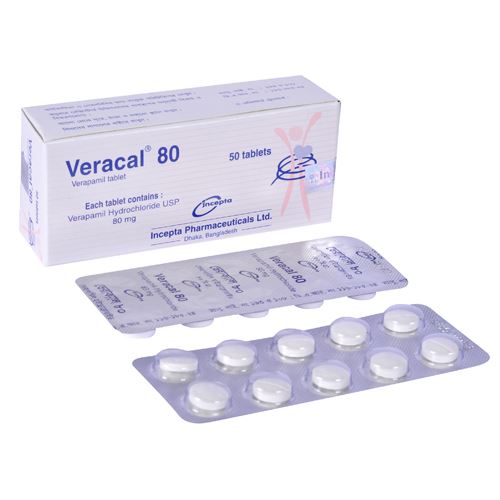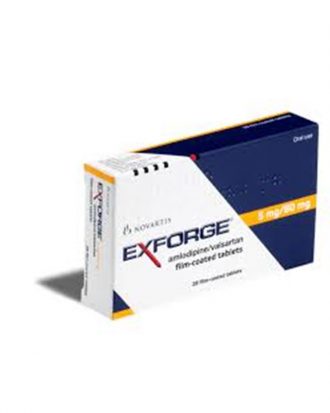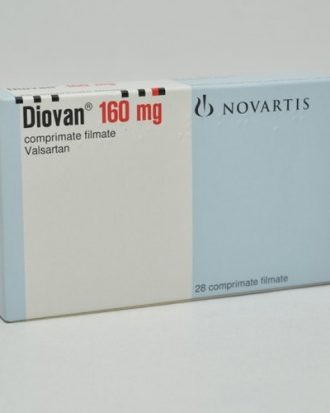Veracal (Tab) 80mg
৳ 5.00
Indications
- Essential hypertension
- Angina pectoris and prevention of re-infarction
- Supraventricular arrhythmias
Verapamil Injection:
- Tachycardias such as: Paroxysmal supraventricular tachycardias
- Atrial fibrillation with rapid ventricular response (except WPWS)
- Atrial flutter with rapid conduction
- Extrasystoles
- Acute hypertension
- Acute coronary insufficiency
For the prophylaxis and / or therapy of ectopic arrhythmias (predominantly ventricular extrasystoles) in halothane anaesthesia and in the application of adrenaline in halothane anaesthesia respectively.
Therapeutic Class
Pharmacology
Dosage & Administration
Verapamil Tablet:
- The dose of Verapamil should be individualized by titration and the drug should be administered with food.
- For essential hypertension the initial dose should be given 180 mg in the morning. If adequate response is not obtained with 180 mg of Verapamil then the dose may be titrated by following manner: 240 mg each morning. 180 mg each morning plus 180 mg each evening. 240 mg every 12 hourly.
- For angina the usual dose is 80 mg to 120 mg three times a day.
- For arrythmias in digitalized patients, Verapamil should be given 240 mg to 360 mg in divided doses, depending on the severity of the condition. Divided doses up to 180 mg/day may occasionally be needed.
Verapamil Injection:
Adults: 5 mg slowly intravenously, in tachycardias and hypertensive crises, if necessary repeat after 5 to 10 minutes. Drip infusion to maintain the therapeutic effect: 5-10 mg/hour in physiological saline, glucose, laevulose or similar solutions, on average up to a total dose of 100 mg/day.
Children:
- Newborn: 0.75-1 mg (0.3-0.4 ml)
- Infants: 0.75-2 mg (0.3-0.8 ml)
- Children age 1-5 years: 2-3 mg (0.8-1.2 ml)
- Age 6-14 years: 2.5-5 mg (1-2 ml)
of Verapamil, given intravenously, depending on age and action. The injection should be made slowly under electrocardiographic control and only until onset of the effect. Intravenous infusion in hypertensive crises: initially 0.05-0.1 mg/kg/hour; if the effect proves to be insufficient, the dose is increased at 30-60 minute intervals until twice the dose or more is reached. Average total dose up to 1.5 mg/kg/day.
Interaction
Contraindications
- Severe left ventricular dysfunction
- Hypotension or cardiogenic shock
- Sick sinus syndrome (except in patients with a functioning artificial ventricular pacemaker)
- Second or third-degree atrioventricular (AV) block (except in patients with a functioning artificial pacemaker)
- Patients with atrial flutter or atrial fibrillation and an accessory by pass tract (eg. Wolff-Parkinson-White, Lown-Ganong-Levine syndrome)
- Patients with known hypersensitivity to verapamil hydrochloride
- Verapamil injection should not be administered intravenously to patients on beta-blockers (except in an intensive care setting) and known hypersensitivity to Verapamil hydrochloride.
Side Effects
- Digestive system: Constipation, nausea;
- Cardiovascular system: Hypotension, edema, CHF, pulmonary edema, bradycardia, AV block;
- Respiratory system: Upper respiratory tract infections;
- Nervous system: Dizziness, headache, fatigue;
- Skin: Rash, flashing;
- Hepatic: Elevated liver enzyme.
Pregnancy & Lactation
Precautions & Warnings
Verapamil may impair ability to drive or operate machinery, particularly in the initial stages of treatment and with concomitant consumption of alcohol. Verapamil markedly slows down the elimination of alcohol and prolongs the duration of the effects of alcohol.
Verapamil should be given as a slow intravenous injection over at least 2 minutes under continuous ECG and blood pressure monitoring. Intravenous injection should only be given by the physician. In atrial fibrillation and simultaneous WPW syndrome there is a risk of inducing ventricular fibrillation






Reviews
There are no reviews yet.